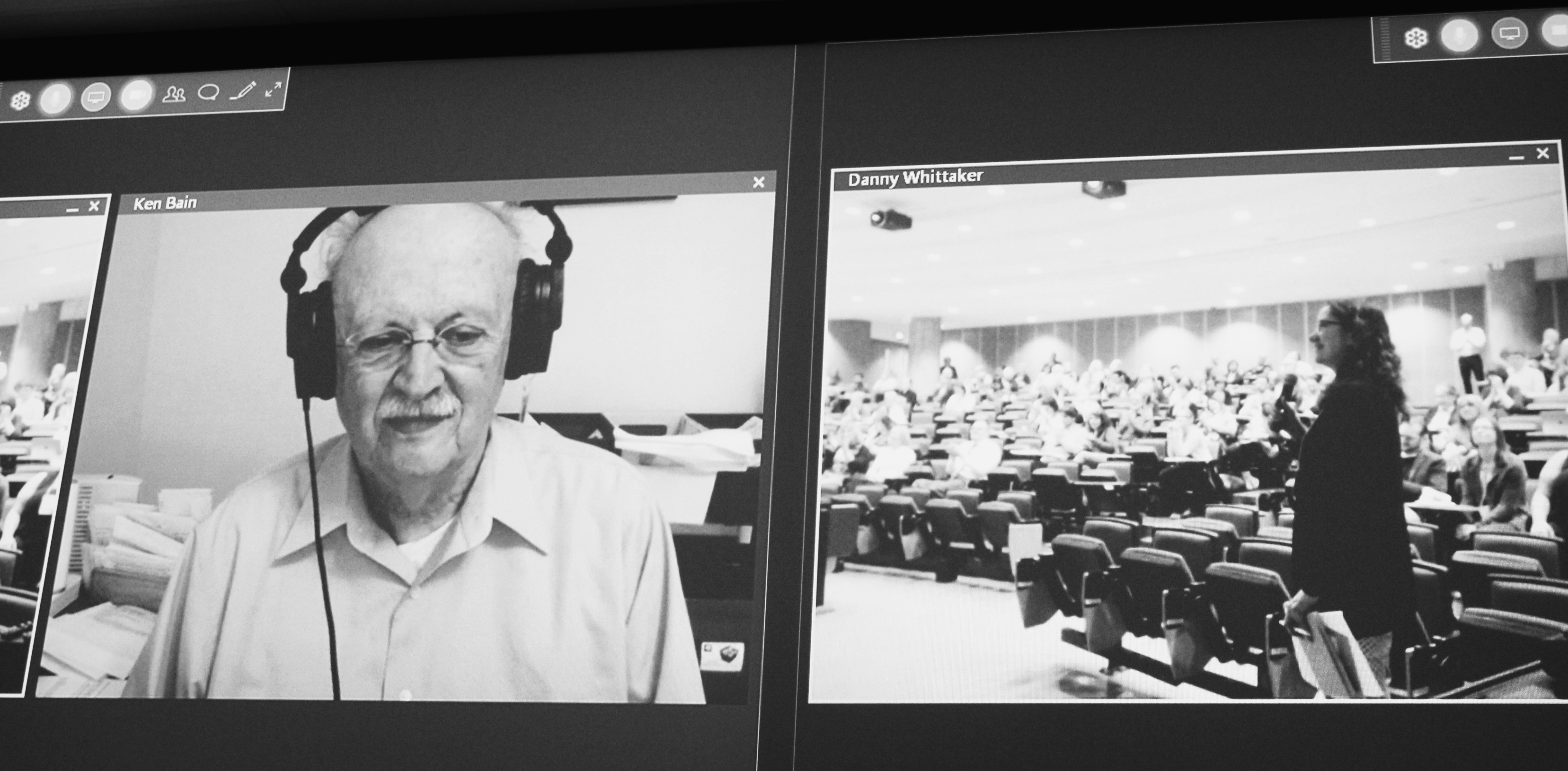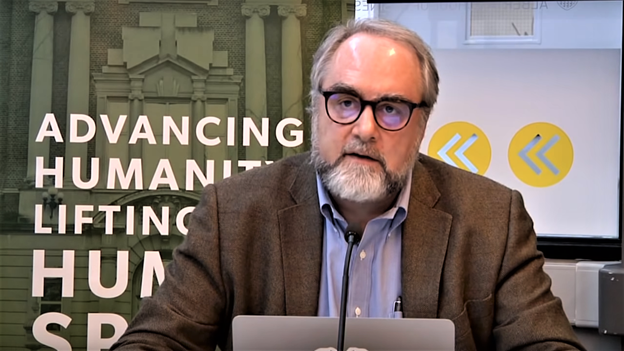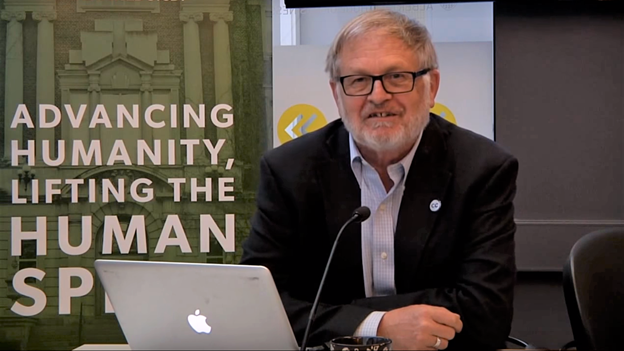
In a recent study by researchers at UCSB, they found that almost one-third of CO2 emissions produced by academic institutions comes from flying to conferences or other academic events, something I’d never even considered. Somehow, academic institutions never screamed giant producers of harmful emissions, but I’d also never thought about how often professors and graduate students needed to travel to reach multiple conferences out of province each year.
So, how can members of the academy help to reduce their carbon footprint come conference season? One solution: attend a conference online. Academic communities can, and should be looking into ways to utilize technology to promote sustainable habits and mobilize ideas.
First Hand Experiences
Geoffrey Rockwell has been key to the success of the e-conferencing experiment here at the U of A. Anchoring discussions and helping to bridge the gaps between technical processes and academic engagement, he has lead the Around the World Conference from North Campus for a number of years. It helps that Geoffrey is not new to e-conferencing. He told me that the first time he, “brought somebody into a class on skype was 1995 or something like that. It wasn’t skype. It didn’t exist then. It was a very interesting product out of Cornell: CU-SeeMe.”

Before sustainability became a goal of the Around the World Conference, the original motivation was to bring together a set of institutes from across the globe; one institute for each time zone. What draws me most to the idea of e-conferencing is the accessibility. Distance has always been a big problem with traditional conferences, as not everyone can attend who wants to. Geoffrey went into more detail, noting, “There’s all sorts of people we don’t hear from… who can’t afford to come to our conferences.” He went on to highlight the importance of putting a voice to what people are reading, even if they live thousands of miles away. “We can be much more intentional with how we use [technology],” he told me. “Who are the people who we could never have brought, who we can now bring [using technology]. And one of the types of people are those with disabilities, who just don’t travel to give talks.”
Over the last five years, staggeringly successful results emerged from the Around the World e-conference. I learned that each year, the conference hosts roughly 44 speakers from up to 12 countries. Over 10% of those speakers are from the University of Alberta, launching early careers for assistant professors and graduate students. A total of $200,000 in flight costs have been saved, and perhaps the most impressive feat of all, the avoidance of over 300 metric tonnes of CO2 emissions — while hosting over 210 research presentations.
Measuring participation in traditional conferences can be done by a simple headcount of the people who come to watch any particular session. There’s also the aspect of engagement in conferences, but it can be a lot more difficult to tell who zoned out during a presentation, or how many times the guy in front of you opened his email when measuring engagement.
Measuring participation in an e-conference is much more nuanced. For example, looking at the Around the World Conference, we looked at the number of livestream and video views as well as website visitors and found that each year, the conference pulls in over 800 visitors across the LiveStream and Youtube. This is a substantial number of people when you consider that a single conference is usually limited by spacial capacity, time, and the cost of travel.
Looking for more information on e-conferences, I turned to a couple of presenters from the Sustainable Research Conference, Jean Polfus and Amy Amos. They had been asked what they felt were the most challenging aspects of attending a regular conference. Both women, heavily involved in academics and the conferences that go with it, gave the same answer: Travel. Polfus shared the time and money it would have taken her had she flown to Edmonton from Tulit’a for the conference, rather than skyping in. “I could leave at 9:30 in the morning and then get to Edmonton by 7pm, and then you’d have to do that the day before,” she begins. But there’s also a return trip. “… leaving at 7 a.m. in the morning from Edmonton I would get back to Tulit’a at 5:30 p.m.” And don’t forget about the cost. “The cost is pretty similar [to Amy Amos] I think, between four and five thousand dollars. So, the small plane flights between the few communities are very very expensive. So I have to take at least some of those to get to the bigger jet that lands in Norman Wells or to get to Yellow Knife… and those cost a lot of money.”
Hosting an E-Conference

Terry Anderson, author of Online Conferences Professional Development for a Network Era, addressed some of the successes and failures of the first online conference he ever hosted in 1992, when he spoke at Sustainable Research Conference. He also shared what he learned from others who had done online conferencing. Anderson detailed that the varying participation of the audience was a good and bad thing. It was bad because there would be those who would “live and breathe the conference for three weeks” and others who would “read two emails.” However, it was also good because people could choose for themselves when and how to spend their time. Anderson went on to detail his involvement in a journal, where using a case study to determine the effect of eco-conferences, they found the carbon emission avoidance was significant. Based on this, he determined that e-conferences are a positive endeavor, saving money for attendees and organizers, saving travel time, and reducing carbon emissions. He ended his talk with a word of advice: “it doesn’t have to be ‘as good as’ to be ‘good.’” This statement was echoed by Geoffrey as both men agreed that an e-conference, despite its technological difficulties at times, does not need to be perfect to be a success.
Final Thoughts
I think people may be most hesitant about e-conferences based on the possible technological barriers involved in the set up, and a fear of losing the popular person to the more attractive in-person networking interactions that are so prevalent in traditional conference settings. But after spending five days sitting down and experiencing an e-conference for all that it was, I think it’s worth it, at the very least, to give one a try. Not only does the conference help the environment — complimenting the 2018 topic of sustainability particularly well — host a multitude of speakers, and cut costs, but it maintains accessibility for anyone and everyone interested in learning more about a topic or idea. Discussions can also be opened up to all participants via live-chats and comment functions even after the sessions have ended since every talk is archived and available for viewing at anytime.
If you’re interested in hosting an e-conference check out the U of A’s own Sustainability resources site for toolkits, tip sheets, and resources available to help get you started.
Shelby Carleton — Arts Work Experience Student, Arts Collaboration Enterprise
Shelby Carleton is in her fourth year of study as an English major at the University of Alberta. She can’t wait to graduate and continue to pursue her passion as a video game designer with her best friend in the whole world, and — maybe hopefully someday in the future — a German Shepherd puppy.